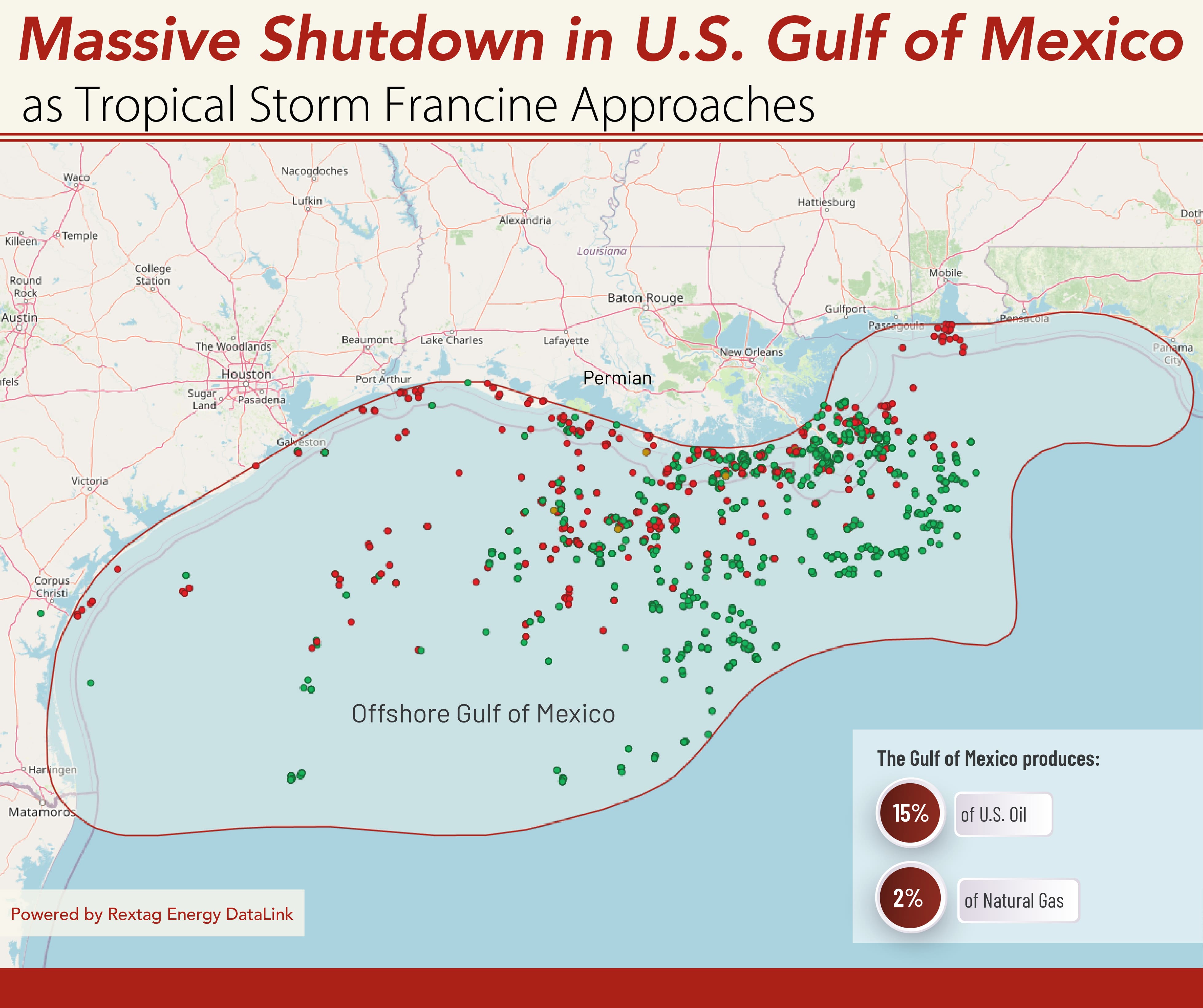Comprehensive Energy Data Intelligence
Information About Energy Companies, Their Assets, Market Deals, Industry Documents and More...
Massive Shutdown in U.S. Gulf of Mexico as Tropical Storm Francine Approaches
09/13/2024
A significant portion of the U.S. Gulf of Mexico's oil and natural gas production has come to a halt as Tropical Storm Francine barrels toward Louisiana, threatening the region's crucial energy infrastructure. In what is shaping up to be one of the most impactful events for U.S. energy this year, approximately 24% of crude oil production and 26% of natural gas output in the Gulf are now offline, according to the U.S. Bureau of Safety and Environmental Enforcement (BSEE).
Francine, with winds reaching 65 mph (100 kph), is currently situated 380 miles (610 km) southwest of Morgan City, Louisiana, and is expected to strengthen into a hurricane by the end of the day. The storm's trajectory is causing widespread disruptions to offshore operations in the Gulf, which plays a vital role in the country’s energy supply.
A Quarter of Gulf Production Shut Down
The Gulf of Mexico accounts for about 15% of the nation’s total oil production and 2% of its natural gas output, making it a critical hub for U.S. energy. As of Tuesday, 412,070 barrels per day (bpd) of oil and 494 million cubic feet per day (mmcfd) of natural gas have been halted due to the storm, according to the latest data from BSEE. This large-scale disruption is having immediate effects on energy markets.
Evacuations and Precautionary Measures
As Francine strengthens, precautionary evacuations are in full swing. Personnel have been removed from 130 production platforms, which represents 35% of the 371 manned platforms operating in the Gulf of Mexico. Additionally, workers were evacuated from two non-dynamically positioned rigs, and three rigs have been moved out of the storm’s path to avoid potential damage.
In the face of such a powerful storm, safety and preparedness are paramount. These platforms and rigs are the backbone of the nation’s offshore oil and gas industry, and protecting them is critical for both worker safety and ensuring the continued flow of energy once the storm passes.
Post-Storm Recovery and Inspections
Once Tropical Storm Francine makes its way past the Gulf, offshore facilities will undergo thorough inspections to assess any potential damage. If the infrastructure remains intact, production can quickly resume. However, platforms and rigs that sustain damage will need repairs before they can be brought back online, potentially delaying full recovery and prolonging the energy supply disruptions.
This event serves as a stark reminder of how natural disasters can suddenly and severely impact U.S. energy infrastructure, with the Gulf of Mexico often being at the center of these storms. With Francine likely to strengthen into a hurricane, the next few days will be critical in determining the extent of the damage and the speed of recovery for the oil and gas industry.
If you are looking for more information about energy companies, their assets, and energy deals, please, contact our sales office mapping@hartenergy.com, Tel. 619-349-4970 or SCHEDULE A DEMO to learn how Rextag can help you leverage energy data for your business.
Talos Energy Confirms $1.29 Billion Takeover of QuarterNorth Energy
![$data['article']['post_image_alt']](https://images2.rextag.com/public/blog/224Blog_Talos Energy acquires QuarterNorth Energy for $1.29 billion.png)
Houston-based Talos Energy Inc. has made a deal to buy QuarterNorth Energy Inc. for $1.29 billion. QuarterNorth is a company that explores and produces oil in the Gulf of Mexico and owns parts of several big offshore fields. This purchase will add more high-quality deepwater assets to Talos's business, which are expected to bring steady production and new opportunities for growth. The deal should immediately benefit Talos's shareholders and help the company reduce its debt faster.
Exploring the Gulf of Mexico: A Comprehensive Data and Map by Rextag
![$data['article']['post_image_alt']](https://images2.rextag.com/public/blog/R 204 (blog) Gulf Mexico Oil and Gas Map_ 2023 Review.png)
Discover the Gulf of Mexico with our comprehensive data and pipeline map. Explore coastal and island information along with oil and gas data
![$data['article']['post_image_alt']](https://images2.rextag.com/public/blog/328_Blog_Why Are Oil Giants Backing Away from Green Energy Exxon Mobil, BP, Shell and more .jpg)
As world leaders gather at the COP29 climate summit, a surprising trend is emerging: some of the biggest oil companies are scaling back their renewable energy efforts. Why? The answer is simple—profits. Fossil fuels deliver higher returns than renewables, reshaping priorities across the energy industry.
![$data['article']['post_image_alt']](https://images2.rextag.com/public/blog/327_Blog_Oil Market Outlook A Year of Growth but Slower Than Before.jpg)
The global oil market is full of potential but also fraught with challenges. Demand and production are climbing to impressive levels, yet prices remain surprisingly low. What’s driving these mixed signals, and what role does the U.S. play?
![$data['article']['post_image_alt']](https://images2.rextag.com/public/blog/326_Blog_USA Estimated Annual Rail CO2 Emissions 2035.jpg)
Shell overturned a landmark court order demanding it cut emissions by nearly half. Is this a victory for Big Oil or just a delay in the climate accountability movement?